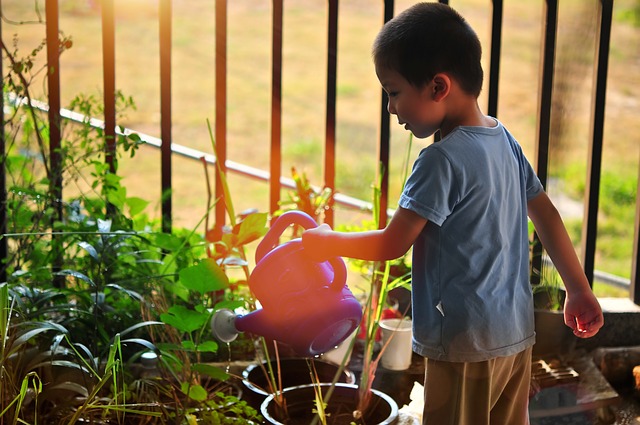Children can learn new skills, have fun, play and develop self-confidence by spending time in the garden tending plants and growing their own food. Most children enjoy being outdoors and love digging in the soil, getting dirty, creating things and watching plants grow. Gardening is an excellent way to keep the kids entertained while homeschooling, and a fun way for them to learn something new and practical.
Children learn from growing things
People of all ages can enjoy gardening, but children in particular will have lots of fun and gain special benefits. Gardening is educational and develops new skills including:
- Responsibility– from caring for plants
- Understanding– as they learn about cause and effect (for example, plants die without water, weeds compete with plants)
- Self-confidence – from achieving their goals and enjoying the food they have grown
- Love of nature – a chance to learn about the outdoor environment in a safe and pleasant place
- Reasoning and discovery – learning about the science of plants, animals, weather, the environment, nutrition and simple construction
- Physical activity – doing something fun and productive
- Cooperation– including shared play activity and teamwork
- Creativity– finding new and exciting ways to grow food
- Nutrition – learning about where fresh food comes from.

Getting children interested in gardening
Some suggestions to get children involved and interested in creating a garden include:
- Keep it simple.
- Give children their own garden space. (This does not have to be big. You can start with a large container or a few pots.)
- Involve older children in the planning and design of the garden.
- Use lightweight, easy-to-handle, correct-sized tools and garden equipment. Make sure that your garden is a safe place, with suitable equipment, tools, fences, gates and paths for children to use.
- Encourage children to dig in the dirt.
- Grow interesting plants such as sunflowers, corn, pumpkins, tomatoes and strawberries.
- Use a trellis or teepee to grow beans or sweet peas.
- Plant flowers that attract butterflies, ladybirds and other interesting insects or birds.
- Make a scarecrow.
- Install a water feature, a birdbath or a sundial.
Planting an educational home garden
This project can be quite easy, though each growing area will vary. Gardens for educational purposes come in all sizes. Determine how much space is available and then go from there. While many people can utilize a small yard, those with less space might consider the use of raised beds, containers, or even a bright windowsill.
Choosing seeds to sow or plants to incorporate will also play a major role in the success of your classroom garden. Edible vegetable plants are best, as they can also be eaten as the growing season progresses. Feedback from students will be essential in order to build anticipation for upcoming garden projects and related formal or informal lessons. As a first-time grower, look for seeds that are easy to direct sow and will germinate readily. More experienced gardeners may opt to grow crops that require more care and attention. Regardless of the crops selected, growing your own educational home garden is sure to be a memorable experience.
Plant selection for children
Children like large, brightly coloured flowers and vegetables that grow quickly. Plants such as sunflowers, corn and pumpkins are good examples.
You should also consider using varieties of plants that have sensory and textural qualities as well. Examples of great sensory plants include:
- Touch – woolly lamb’s ear, succulents (such as aloe vera), bottlebrush species, snapdragons
- Taste – basil, strawberries, peas, rosemary, carrots, cherry tomatoes
- Smell – jasmine, sweet peas, lavender, geraniums, native mint bush, lemon balm
- Bright color – daffodils, rainbow chard, marigolds, pansies, sunflowers
- Sound – corn, bamboo and grasses rustle against each other when the wind blows.
Source:

